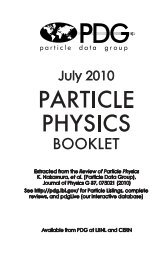30. Passage of particles through matter 1 - Particle Data Group
30. Passage of particles through matter 1 - Particle Data Group
30. Passage of particles through matter 1 - Particle Data Group
Create successful ePaper yourself
Turn your PDF publications into a flip-book with our unique Google optimized e-Paper software.
<strong>30.</strong> <strong>Passage</strong> <strong>of</strong> <strong>particles</strong> <strong>through</strong> <strong>matter</strong> 11<br />
<strong>30.</strong>2.5. Energetic knock-on electrons (δ rays) : The distribution <strong>of</strong> secondary<br />
electrons with kinetic energies T ≫ I is [2]<br />
d 2 N<br />
dTdx<br />
= 1<br />
2 Kz2Z<br />
A<br />
1<br />
β 2<br />
F(T)<br />
T 2<br />
(<strong>30.</strong>8)<br />
for I ≪ T ≤ Tmax, where Tmax is given by Eq. (<strong>30.</strong>5). Here β is the velocity<br />
<strong>of</strong> the primary particle. The factor F is spin-dependent, but is about unity for<br />
T ≪ Tmax. For spin-0 <strong>particles</strong> F(T) = (1 − β 2 T/Tmax); forms for spins 1/2 and<br />
1 are also given by Rossi [2]( Sec. 2.3, Eqns. 7 and 8). For incident electrons, the<br />
indistinguishability <strong>of</strong> projectile and target means that the range <strong>of</strong> T extends only<br />
to half the kinetic energy <strong>of</strong> the incident particle. Additional formulae are given in<br />
Ref. 23. Equation (<strong>30.</strong>8) is inaccurate for T close to I [24].<br />
δ rays <strong>of</strong> even modest energy are rare. For a β ≈ 1 particle, for example, on<br />
average only one collision with Te > 10 keV will occur along a path length <strong>of</strong> 90<br />
cm <strong>of</strong> Ar gas [1].<br />
A δ ray with kinetic energy Te and corresponding momentum pe is produced at<br />
an angle θ given by<br />
cos θ = (Te/pe)(pmax/Tmax) , (<strong>30.</strong>9)<br />
where pmax is the momentum <strong>of</strong> an electron with the maximum possible energy<br />
transfer Tmax.<br />
MeV g −1 cm 2 (Electonic loses only)<br />
3.0<br />
2.5<br />
2.0<br />
1.5<br />
1.0<br />
Silicon<br />
Bethe<br />
Restricted energy loss for:<br />
Tcut = 10 dE/dx|min<br />
Tcut = 2 dE/dx|min<br />
Landau/Vavilov/Bichsel Δp/x for:<br />
x/ρ = 1600 μm<br />
320 μm<br />
80 μm<br />
0.5<br />
0.1 1.0 10.0 100.0<br />
Muon kinetic energy (GeV)<br />
1000.0<br />
Figure <strong>30.</strong>6: Bethe dE/dx, two examples <strong>of</strong> restricted energy loss, and<br />
the Landau most probable energy per unit thickness in silicon. The change<br />
<strong>of</strong> ∆p/x with thickness x illustrates its a ln x + b dependence. Minimum<br />
ionization (dE/dx|min) is 1.664 MeV g −1 cm 2 . Radiative losses are excluded.<br />
The incident <strong>particles</strong> are muons.<br />
June 18, 2012 16:19







